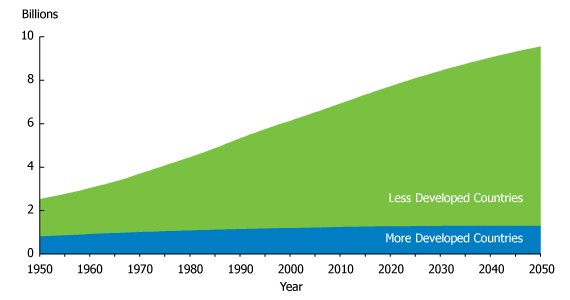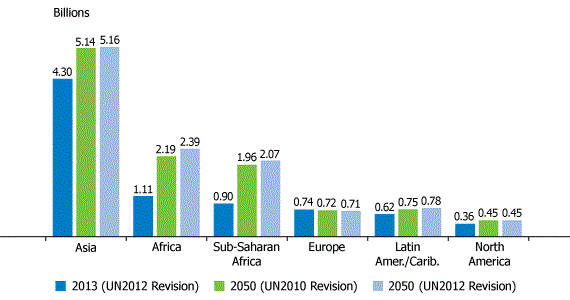
United Nations Raises Projected World Population
The United Nations Population Division has just released its comprehensive estimates and projections, World Population Prospects: The 2012 Revision. The results show a larger global population size in 2050, 9.6 billion, up from the 9.3 billion that the UN projected in its 2010 Revision. A major reason for the higher projection is higher fertility (birth rates) in some countries than previously estimated, particularly in Africa. Much of that information comes from recent demographic surveys.
The overall pattern of projected growth in the developed and developing countries is shown in Figure 1, a pattern that has changed little over the years. Before looking at more-detailed results, however, it is important to take a careful look at the assumptions demographers must make in producing projections.
Figure 1
World Population, 1950–2050

Source: United Nations Population Division, World Population Prospects, the 2012 Revision (Medium Variant).
Making the Assumptions
Any projection involves speculating about the future and just how populations might grow or decline and just how slowly or quickly they might do that. Fertility is a powerful determinant, and is represented by the total fertility rate (TFR, or the average number of children per woman). Globally, past and present trends in the TFR vary widely. There are countries with high TFRs, 5 children or more, where births are either not coming down or are doing so very slowly; others have decreased to moderate levels, leaving open the question of whether their TFRs will continue to decline; still others have declined to very low, even historically low, levels and show little sign of increasing. In making projections, these issues must obviously be addressed. There is always the option of making more than one projection with different assumptions in order to consider other possible paths. The UN does this, although its middle scenario, the Medium Variant, is by far the one most often quoted. Future mortality, the second component of population change, also requires assumptions. This is truer in countries with relatively high mortality and low life expectancy, where there may be considerable room for improvement. Finally, immigration plays a significant role in some countries.
Of those three components, fertility frequently plays the most important role, particularly when it is high or very low. How might one project the future of the TFR? It has been customary to assume that the TFR in higher fertility countries will decline in a pattern similar to what happened in countries that have experienced TFR decline.
For example, here are three countries with varying fertility levels: Niger, Pakistan, and Germany. In Niger, the 2012 Demographic and Health Survey (DHS) put the TFR at 7.6 children per woman, actually higher than the TFR from a DHS conducted six years earlier. The UN assumes that Niger’s TFR may decline to 5 children per woman by mid-century, certainly a reasonable assumption, but one that is also a full child higher in 2050 than was assumed in the UN’s 2010 round of projections. In 2010, the UN had projected a 2050 population of 55 million for Niger, up from about 17 million, but the new projection is 69 million. Projections are indeed a continuous process of evaluation and revision.
The UN Medium Variant clearly assumes that the effective use of family planning will result in reductions in TFRs, even where it appears not to be taking place. As John Wilmoth, director of the United Nations Population Division, stated: “The medium-variant projection is thus an expression of what should be possible if future patterns of behavioral change in childbearing resemble those of the past, for populations at similar levels of fertility. These future trends, however, are not guaranteed. In fact, in light of recent trends for some high-fertility countries, this middle scenario could require additional substantial efforts to make it possible.”
Pakistan has been experiencing fertility decline in recent years and the UN has assumed that trend will continue. However, there have been numerous cases in which the TFR declined to some lower value but the decline then “stalled.” Pakistan may be one of these cases. Germany has had very low fertility for about 40 years. For Germany, the UN assumes that there will be very modest “recovery” in the TFR to about 1.7 children from the current 1.36. Although there has been no TFR increase yet, the assumption does not seem extreme.
For world regions, sub-Saharan Africa is projected to have the largest growth of 1.2 billion by 2050, even more than population giant Asia. For other world regions, growth is projected to be far more modest, and population decline is expected in Europe. Sub-Saharan Africa is also the region with the greatest possible future variation, given its high fertility and uncertain future fertility trends (see Figure 2).
Figure 2
Current and Projected Population Totals by World Region

Source: United Nations Population Division, World Population Prospects, the 2010 and 2012 Revisions (Medium Variants).
The Other Scenarios
The UN produces three main scenarios: Low, Middle, and High variants. The Low and High variants are similar to the Medium except that the TFR is one-half child less and one-half child more than the Medium. Under these three variants, world population in 2050 is projected at 8.3 billion (low), 9.6 billion (medium), and 10.9 billion (high). The largest variation by far is among the less developed countries. The UN also produces projections to illustrate the impact of demographic trends, although these are somewhat unlikely. For fertility, there is a Constant Fertility projection as well as an Instant Replacement, showing what would happen if all countries suddenly had TFRs of 2.1. In the case of Niger, the Constant Fertility Variant is 86 million population in 2050, growing at a rate that would double its population every 16 years. While such growth would certainly be unsustainable, this scenario greatly improves our understanding of population dynamics. The Zero Migration Variant projects a U.S. population in 2050 of 344 million instead of 401 million as in the Medium Variant.
The UN has also run its projections toward a more distant “horizon”—to 2100. While that is very far into the future, it is informative to look at the long-term consequences of earlier trends. It also reminds us that many countries will continue growing (or declining) after 2050. The projections range from 6.8 billion (low) to 10.9 billion (medium) to 16.6 billion (high). Under the High Variant, sub-Saharan Africa’s population would rise to 5.4 billion.
The UN projection series is more than just a “forecasting” project, it’s a valuable tool that quantifies a variety of aspects of demographic change, giving us a thorough examination of the demographic world we will live in and why. The full set of projections is available at: http://esa.un.org/unpd/wpp/index.htm.






